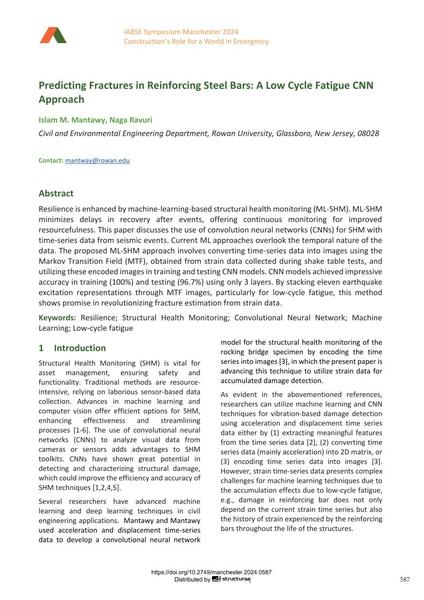Predicting Fractures in Reinforcing Steel Bars: A Low Cycle Fatigue CNN Approach

|
|
|||||||||||
Détails bibliographiques
| Auteur(s): |
Islam M. Mantawy
(Civil and Environmental Engineering Department, Rowan University, Glassboro, New Jersey, 08028)
Naga Ravuri (Civil and Environmental Engineering Department, Rowan University, Glassboro, New Jersey, 08028) |
||||
|---|---|---|---|---|---|
| Médium: | papier de conférence | ||||
| Langue(s): | anglais | ||||
| Conférence: | IABSE Symposium: Construction’s Role for a World in Emergency, Manchester, United Kingdom, 10-14 April 2024 | ||||
| Publié dans: | IABSE Symposium Manchester 2024 | ||||
|
|||||
| Page(s): | 587-595 | ||||
| Nombre total de pages (du PDF): | 9 | ||||
| DOI: | 10.2749/manchester.2024.0587 | ||||
| Abstrait: |
Resilience is enhanced by machine-learning-based structural health monitoring (ML-SHM). ML-SHM minimizes delays in recovery after events, offering continuous monitoring for improved resourcefulness. This paper discusses the use of convolution neural networks (CNNs) for SHM with time-series data from seismic events. Current ML approaches overlook the temporal nature of the data. The proposed ML-SHM approach involves converting time-series data into images using the Markov Transition Field (MTF), obtained from strain data collected during shake table tests, and utilizing these encoded images in training and testing CNN models. CNN models achieved impressive accuracy in training (100%) and testing (96.7%) using only 3 layers. By stacking eleven earthquake excitation representations through MTF images, particularly for low-cycle fatigue, this method shows promise in revolutionizing fracture estimation from strain data. |
||||
